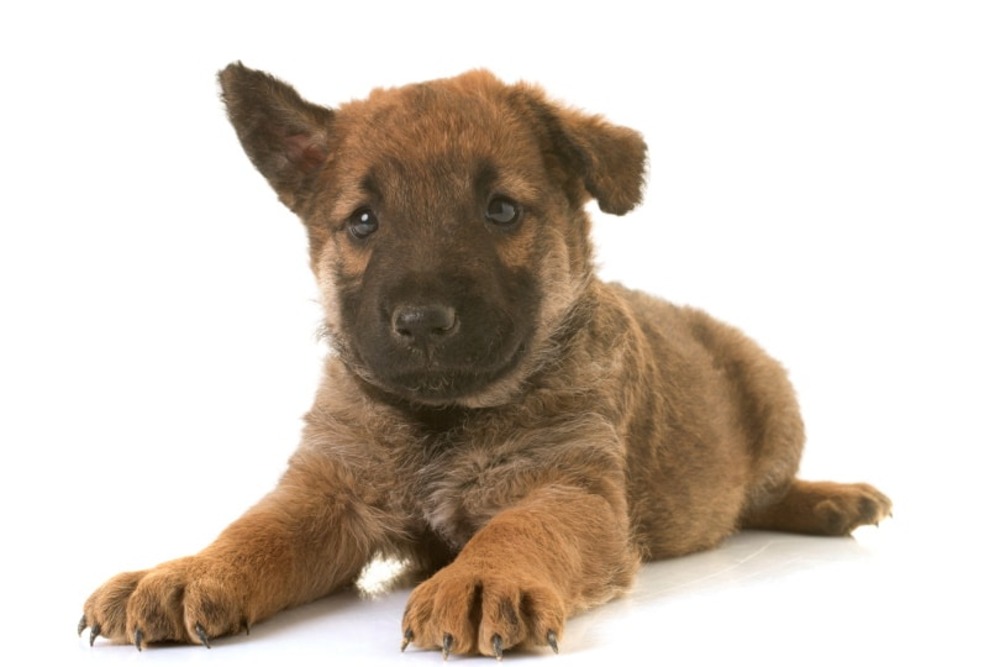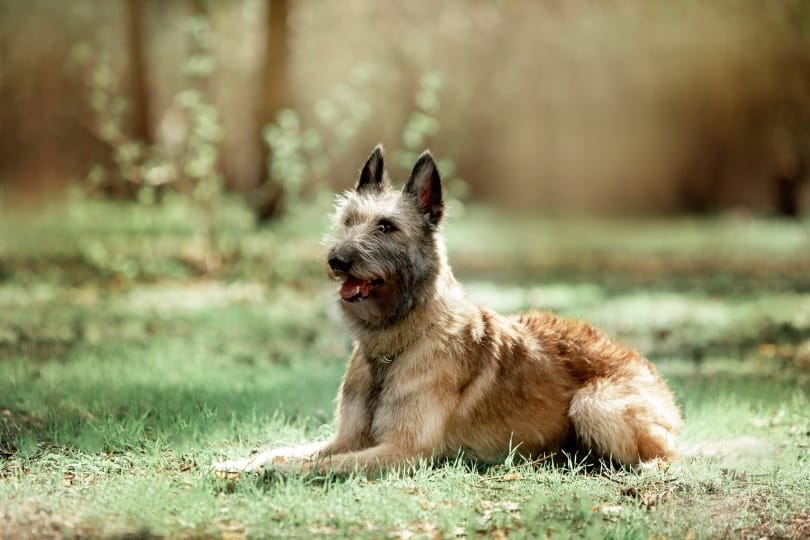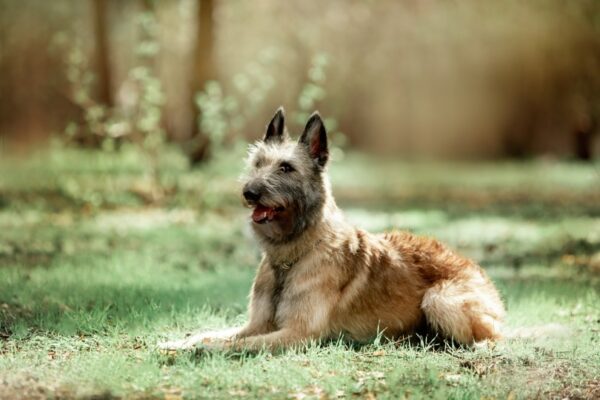Click Below to Skip Ahead
The Belgian Laekenois is one of the four herding dogs from Belgium. All these dogs are called “Belgian Shepherds,” but they are technically different breeds.
The Laekenois is a medium-sized dog that’s built very practically. They have an athletic body, as they were built to work all day. They’re known for their intelligence and alertness. After all, they were herding dogs, and they had to figure out a lot of stuff on their own while on the job.
Breed Overview
Height:
22–26 inches
Weight:
44–66 pounds
Lifespan:
12–14 years
Colors:
Shades of red, fawn, or gray
Suitable for:
Active, experienced dog owners
Temperament:
Intelligent, active, alert
Belgian Shepherds, in general, have started gaining popularity, largely due to the Belgian Malinois. All of these breeds have some temperament traits alike, but they’re also pretty different.
Laekenois are intelligent and eager to please. They’re easy to train, and they can be relatively protective of their family. However, they can also be a lot of work. They’re high-energy dogs that need plenty of exercise. They’re also intelligent, making them get bored pretty easily.
Therefore, we only recommend this breed for experienced dog owners who plan to do a lot with their dogs.
Belgian Shepherd Laekenois Characteristics

Belgian Shepherd Laekenois Puppies
Like most puppies, Laekenois puppies are very energetic. They need plenty of playtime and exercise to keep them occupied. Socialization is vital to ensure they are comfortable around different animals and people. Due to their natural protective instincts, these dogs may require more socialization than your average canine.
Training is important, too. These dogs respond readily to training, but you can make the most of it by getting them started early. They tend to go through a mouthing phase, and they may need consistent training to help curb this behavior.
Finding a Laekenois puppy can be challenging, as these dogs are exceptionally rare. We recommend looking for reputable breeders who prioritize the health of their dogs. Temperament testing and early socialization are both important factors, too.

Belgian Shepherd Laekenois Origin & History
As you might expect, these dogs were developed in Belgium, likely alongside other Belgian Shepherds. They’re named after Laeken, which is near Brussels. Originally, they were bred for herding and guarding livestock, which led to the development of their intelligence and work ethic.
The Belgian Shepherd Club was formed in 1891, aiming to define the characteristics of their native herding breeds. Some kennel clubs recognize the Laekenois as a different coat variant of “Belgian Shepherds.” However, some others recognize them as separate breeds.
This breed’s numbers decreased sharply after the World Wars. However, breeders worked diligently to restore Laekenois numbers, and they have gotten a bit better today. However, they are still the rarest of the Belgian Shepherd breeds.
Temperament & Intelligence of the Belgian Shepherd Laekenois
The Belgian Laekenois is a breed known for being highly trainable and intelligent. They’re quick to pick up on commands and learn new things fast, especially if you keep training sessions engaging. They’re also intelligent beyond their simple commands. They’re creative and can figure things out on their own, but this can come back to haunt you if you allow them to get bored.
These dogs are also very alert and watchful, largely due to their herding instincts. They are naturally protective of their family and surroundings. They also bond closely with their family, and they’re exceptionally affectionate. However, they don’t bond readily with strangers and can be a bit aloof.
After all, these dogs were bred to be protective. To counteract this trait, early socialization is helpful to prevent excessive shyness and aggression. Socialization is important for every breed, but it is especially important for this one. Laekenois are very active and energetic, too. They’re lively companions who need lots of exercise and mental stimulation. Otherwise, they can become bored and destructive.
Are These Dogs Good for Families? 👪
Belgian Laekenois can be good for families, but they aren’t good for every family. There is a lot you need to keep in mind when deciding whether or not to adopt one of these dogs.
They bond strongly with their family and enjoy spending time with them. They’re exceptionally loyal and affectionate, making them great family dogs in certain situations. With proper training, they can be well-mannered companions. Because they are so easily trainable, getting them to behave in a home isn’t usually a problem.
These dogs are also protective, which can either be negative or positive. They can be trained to be guard dogs and protect their family. However, they are also wary of strangers, creating potential challenges.
These dogs also require lots of exercise, potentially leading to issues for some families. Their herding instincts can also manifest as nipping and herding behaviors. You’ll need to correct these during training to ensure that these dogs don’t grow up to be mouthy.
Does This Breed Get Along with Other Pets? 🐶 😽
Belgian Laekenois can get along with other pets. However, this isn’t always the case. Unlike some other breeds, they don’t have a strong prey drive. Therefore, they don’t tend to chase small animals. They were bred for herding, not hunting.
Early socialization and training can really help them get along with other dogs and pets. They tend to pick up on things relatively easily, allowing them to learn the proper behaviors faster. However, their herding instincts can manifest as nipping towards other pets, especially smaller animals like cats. Consistent training can help manage this, but it’s still important to keep in mind.
Their wariness of strangers can extend to unfamiliar pets, as well. Supervised introductions and positive reinforcements are key. Otherwise, they may assume that the other dog is a threat.

Things to Know When Owning a Belgian Laekenois
Food & Diet Requirements 🦴
Belgian Laekenois are very active dogs, so they thrive on a diet rich in protein. Often, they do well on commercial food designed for high-energy dogs and athletes. Very active Laekenois may need to be fed more food than what’s suggested on the bag. However, less active dogs can become obese if fed too much. It’s important to keep an eye on your dog’s portion sizes and body condition.
You should also consider your dog’s age. Puppies need different nutrition from adults, so they require special food. Ensure that you feed your dog a puppy formula when they are younger, replacing it with an adult formula once they quit growing. Not meeting your puppy’s nutritional needs can lead to health problems later on.
Beyond that, these dogs don’t have any particular health issues to keep in mind when it comes to their diet. The biggest consideration should be portion control. They may need their food increased or decreased as their activity level changes.
Exercise 🐕
The Belgian Laekenois are very active dogs, so they need a significant amount of exercise. We recommend at least 60 minutes of dedicated activity daily. These activities need to be pretty intense. Leisurely strolls aren’t going to get their needs met. Instead, you have to try jogging and hiking.
Aim for at least two walks a day, lasting 30 minutes or more each. If you’re an active runner, your Laekenois will be a great companion. They also like to play in safe, fenced-in areas, especially if you implement training and games into their activities.
Laekenois also needs mental stimulation. They crave mental challenges, such as interactive toys, puzzle feeders, and obedience training. These training sessions help keep them engaged and prevent boredom. Don’t forget about their mind, or you’ll end up with a very destructive dog on your hands.
Consider training your dog for canine sports, like agility training, dock diving, and obedience. Even if you don’t want your dog to compete in these sports, training for them can keep your dog’s mind active.
You should start training your dog when they’re young. However, don’t push them too hard before they’re adults. Otherwise, you may damage their new joints and growth plates. Pay attention to your puppy’s cues and stop exercising before they become overly exhausted.
Not getting your dog enough exercise can lead to destructive behaviors like weight gain, behavioral problems, chewing, digging, and barking.
Training 🎾
Belgian Laekenois are known for their intelligence and eagerness to please. They excel in all sorts of training, but it is still important to train them. They do well with positive reinforcement techniques, as they naturally want to make their owners happy.
Start training early, preferably during puppyhood. These dogs learn best if you start obedience training before 12 weeks. Remember, they are learning obedience at this age, so they may progress slowly. However, it’s still important to get their feet wet.
Do short, frequent training exercises, as these are much more effective than long, drawn-out ones. Multiple sessions a day are much better than one longer session. While they are very trainable, these dogs do not have a very long attention span. Consistency is very important. Use the same commands, rewards, and cues all the time. Ensure that everyone uses these same commands to keep your dog from getting confused.
Start with the fundamental commands, as these provide the foundation for more advanced training. Leash training is also highly recommended. After all, your dog must be controlled during walks and outings. Positive reinforcement can help eliminate leash pulling, too.
Go beyond basic commands, though. These dogs are very trainable, so it’s best to take full advantage of their intelligence.
Grooming ✂️
The Belgian Laekenois has a wiry, double coat, which requires regular grooming. Otherwise, it can become matted and unhealthy. The cornerstone of Laekenois grooming is brushing 2–3 times a week. Brushing helps remove loose hair, dirt, and debris from your dog’s coat. It can also prevent tangles and mats, which can cause sores if they’re left to fester.
We recommend using a slicker brush for the topcoat and an undercoat rake for the undercoat. Shedding season occurs twice a year, and you’ll need to brush more during this time.
Laekenois doesn’t need frequent bathing. We do recommend using a high-quality shampoo that doesn’t contain any harsh chemicals, as these can dry out your dog’s coat. You may need to bathe more if your dog gets particularly dirty, as well. It’s vital to thoroughly rinse out all of the shampoo to prevent skin irritation. Otherwise, the shampoo can damage their fur.
You also need to regularly trim your dog’s nails, preventing them from getting too long and uncomfortable. Check your dog’s ears weekly for redness and discharge, as these can be signs of infection. You’ll want to clean them gently with an ear cleaner if you notice any built-up dirt or grime.
Dental health is also very important. Brushing your dog’s teeth at least a couple of times a week is recommended, as this prevents most oral problems. Dogs can get gum disease and cavities, just like people.
Start acclimating your Laekenois puppy to grooming routines right away. Even if they don’t need much grooming as a puppy, it helps to get them used to the process now. Investing in quality brushes and shampoos can also make your grooming much easier.
Health and Conditions 🏥
The Belgian Laekenois is a healthy breed. They were bred to work, after all. However, they can still be prone to some health problems.
The most serious and common health problem is hip dysplasia, which occurs when your dog’s hip joint doesn’t form correctly. It can cause arthritis-like symptoms at a very early age, leading to pain and lameness. There is no cure for this condition, so it is often managed with medication. Elbow dysplasia can also occur, but it is much less common.
Hypothyroidism occurs in some of these dogs, causing the thyroid gland to not produce enough hormones. Often, this leads to weight gain, lethargy, and skin problems. Regular vet checks are important for early detection. Treatment early often helps prevent complications.
Eye diseases can also occur. Cataracts and progressive retinal atrophy both affect vision and occur in this shepherd breed. Regular eye exams can help a vet diagnose this problem, but they may not be curable.
- Eye diseases
- Hip dysplasia
- Epilepsy
- Hypothyroidism
Male vs. Female
Males are typically larger and heavier in this breed than females. Males often weigh upwards of 55 pounds, while females typically weigh less than that. Some temperament differences may exist. However, these aren’t set in stone, as dogs vary in temperament individually.
If your dog is not spayed or neutered, they will exhibit reproductive-related behaviors. However, if your dog is spayed or neutered, then these differences will dissipate.
3 Little-Known Facts About the Belgian Shepherd Laekenois
1. This breed likely has royal roots.
While we don’t know much about this breed’s origin, many believe that the Laekenois was favored by the Belgian Royal Family, especially in the 19th century. Their association with this royal family may have contributed to their name.
2. During the World Wars, this breed almost went extinct.
Instead of being utilized as herding dogs, this breed was utilized as a messenger dog. However, this role exposed them to the dangers of the war. Many breeders worked after the war to improve the breeds’ numbers. However, they remain one of the rarest varieties.
3. Their wiry coat isn’t just for show.
The Laekenois’ double coat is water-resistant. The outer coat repels water, while the dense undercoat provides insulation. While that doesn’t mean they never get wet, it does mean that they have a little extra protection.

Final Thoughts
Belgian Shepherd Laekenois is often considered a protective family dog. While this is true, these dogs can also be tons of work. Most people who are interested in them don’t understand just how much socialization, training, exercise, and mental stimulation these dogs need! You can easily dedicate hours a week to these dogs, which is more than the average dog owner is willing to do.
Before adopting one, we highly recommend ensuring that you can handle one of these dogs. It’s easy for them to get overwhelming.
However, when raised properly, these dogs can be great companions. They’re loyal and very intelligent, making them suitable for a range of tasks and responsibilities.
Featured Image Credit: Marry Kolesnik, Shutterstock







